CIVIL LAW: Analysis of Property Rights on Summer Island (LAWS604)
VerifiedAdded on 2022/10/17
|10
|1562
|25
Report
AI Summary
This Civil Law assignment analyzes a scenario involving a motel business on Summer Island and explores various property law issues. The analysis covers the interpretation of a right of way, examining whether vehicle use and tree cutting are permitted under the grant. It also addresses the enforceability of a covenant granted by a neighboring landowner, discussing the requirements for securing covenant obligations and binding future owners. Furthermore, the assignment examines the legal aspects of a garage lease, including whether a handshake agreement constitutes a valid short-term lease and the implications for the lessee's rights. Finally, the report considers the enforceability of a lease assignment and whether the lessee is bound by a restrictive covenant regarding driving on the island roads. The analysis references relevant sections of the Property Law Act and case law, including Walshe v MacRae, Tulk v Moxhay, and Austerberry v Oldham Corporation, to support the legal arguments.
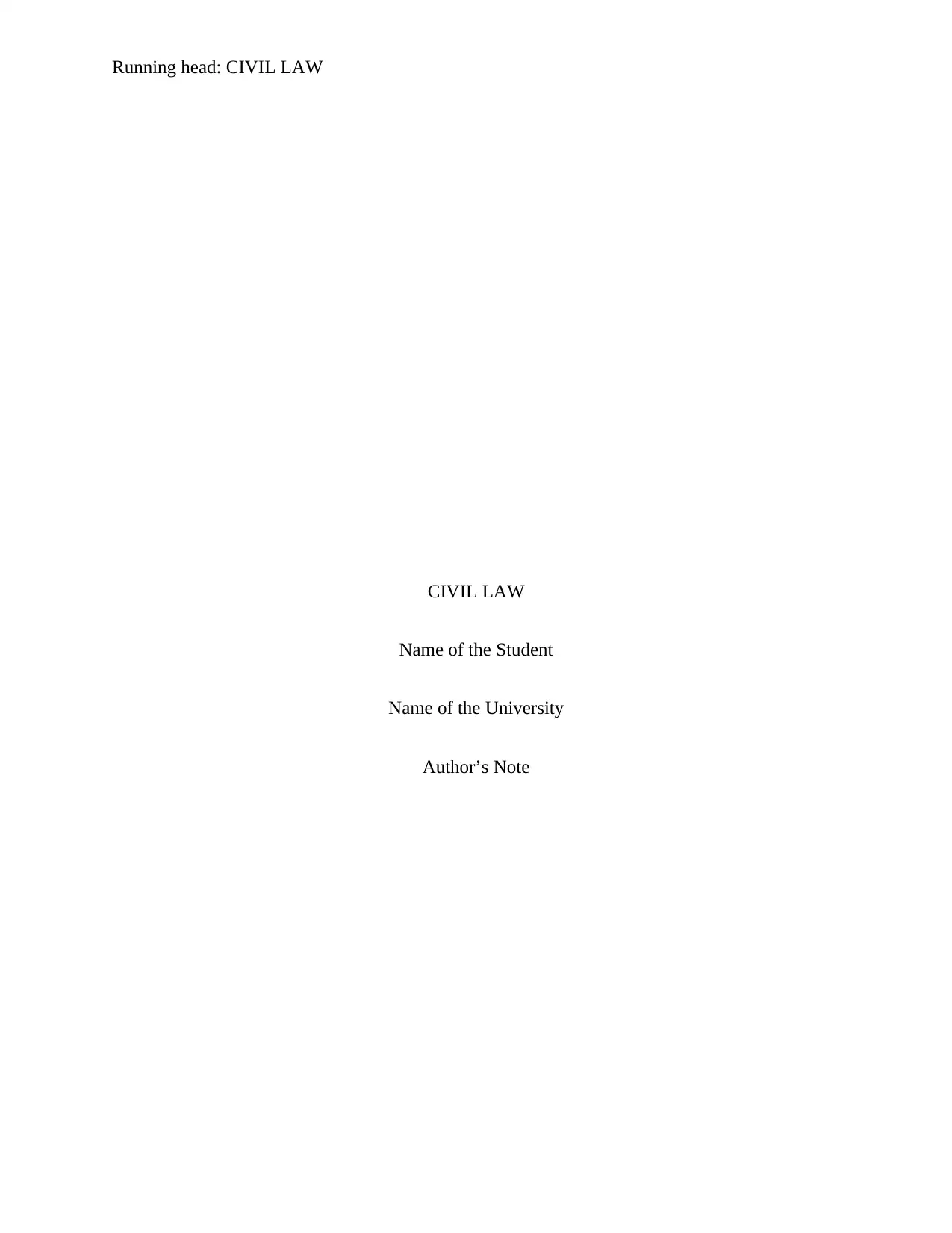
Running head: CIVIL LAW
CIVIL LAW
Name of the Student
Name of the University
Author’s Note
CIVIL LAW
Name of the Student
Name of the University
Author’s Note
Paraphrase This Document
Need a fresh take? Get an instant paraphrase of this document with our AI Paraphraser
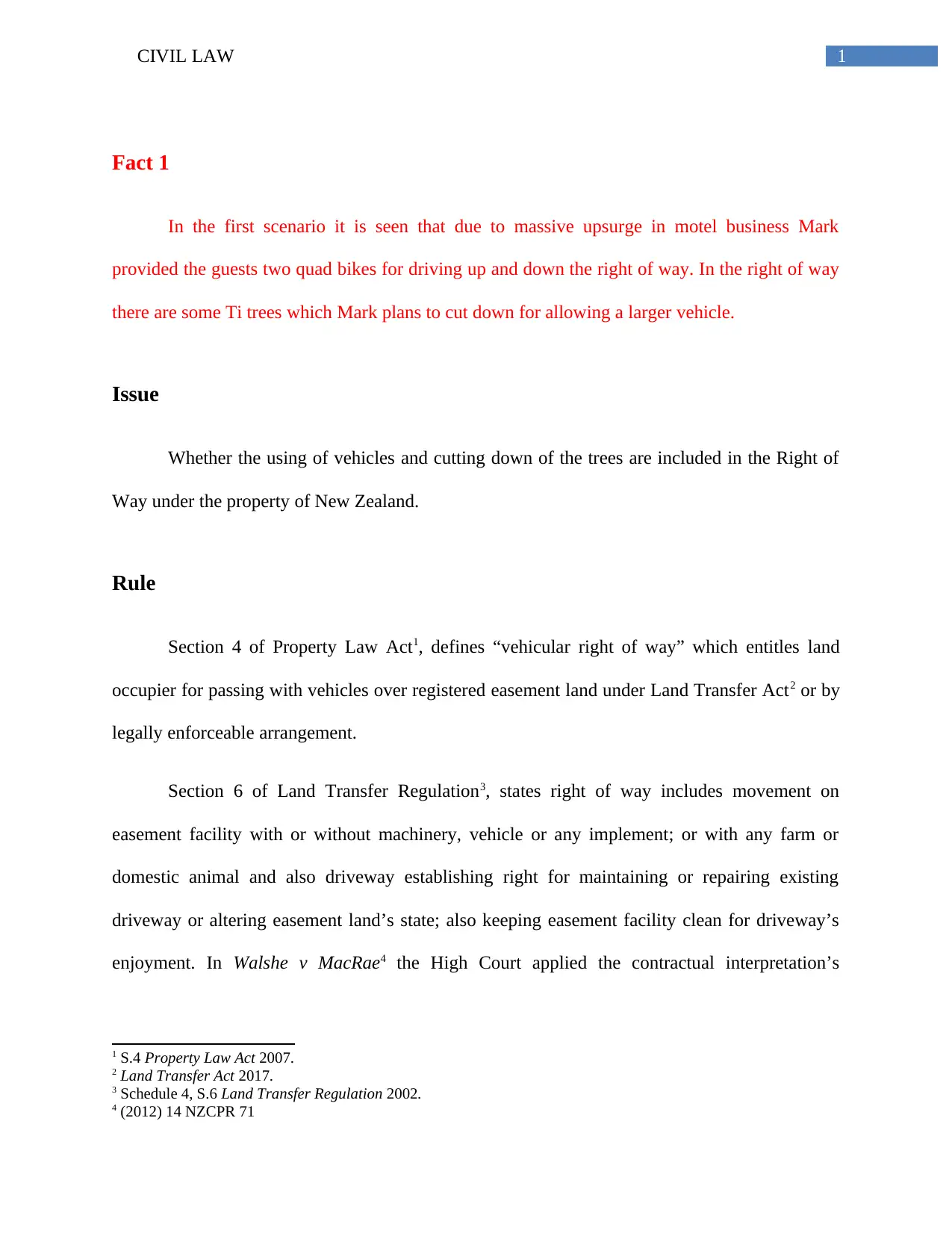
1CIVIL LAW
Fact 1
In the first scenario it is seen that due to massive upsurge in motel business Mark
provided the guests two quad bikes for driving up and down the right of way. In the right of way
there are some Ti trees which Mark plans to cut down for allowing a larger vehicle.
Issue
Whether the using of vehicles and cutting down of the trees are included in the Right of
Way under the property of New Zealand.
Rule
Section 4 of Property Law Act1, defines “vehicular right of way” which entitles land
occupier for passing with vehicles over registered easement land under Land Transfer Act2 or by
legally enforceable arrangement.
Section 6 of Land Transfer Regulation3, states right of way includes movement on
easement facility with or without machinery, vehicle or any implement; or with any farm or
domestic animal and also driveway establishing right for maintaining or repairing existing
driveway or altering easement land’s state; also keeping easement facility clean for driveway’s
enjoyment. In Walshe v MacRae4 the High Court applied the contractual interpretation’s
1 S.4 Property Law Act 2007.
2 Land Transfer Act 2017.
3 Schedule 4, S.6 Land Transfer Regulation 2002.
4 (2012) 14 NZCPR 71
Fact 1
In the first scenario it is seen that due to massive upsurge in motel business Mark
provided the guests two quad bikes for driving up and down the right of way. In the right of way
there are some Ti trees which Mark plans to cut down for allowing a larger vehicle.
Issue
Whether the using of vehicles and cutting down of the trees are included in the Right of
Way under the property of New Zealand.
Rule
Section 4 of Property Law Act1, defines “vehicular right of way” which entitles land
occupier for passing with vehicles over registered easement land under Land Transfer Act2 or by
legally enforceable arrangement.
Section 6 of Land Transfer Regulation3, states right of way includes movement on
easement facility with or without machinery, vehicle or any implement; or with any farm or
domestic animal and also driveway establishing right for maintaining or repairing existing
driveway or altering easement land’s state; also keeping easement facility clean for driveway’s
enjoyment. In Walshe v MacRae4 the High Court applied the contractual interpretation’s
1 S.4 Property Law Act 2007.
2 Land Transfer Act 2017.
3 Schedule 4, S.6 Land Transfer Regulation 2002.
4 (2012) 14 NZCPR 71
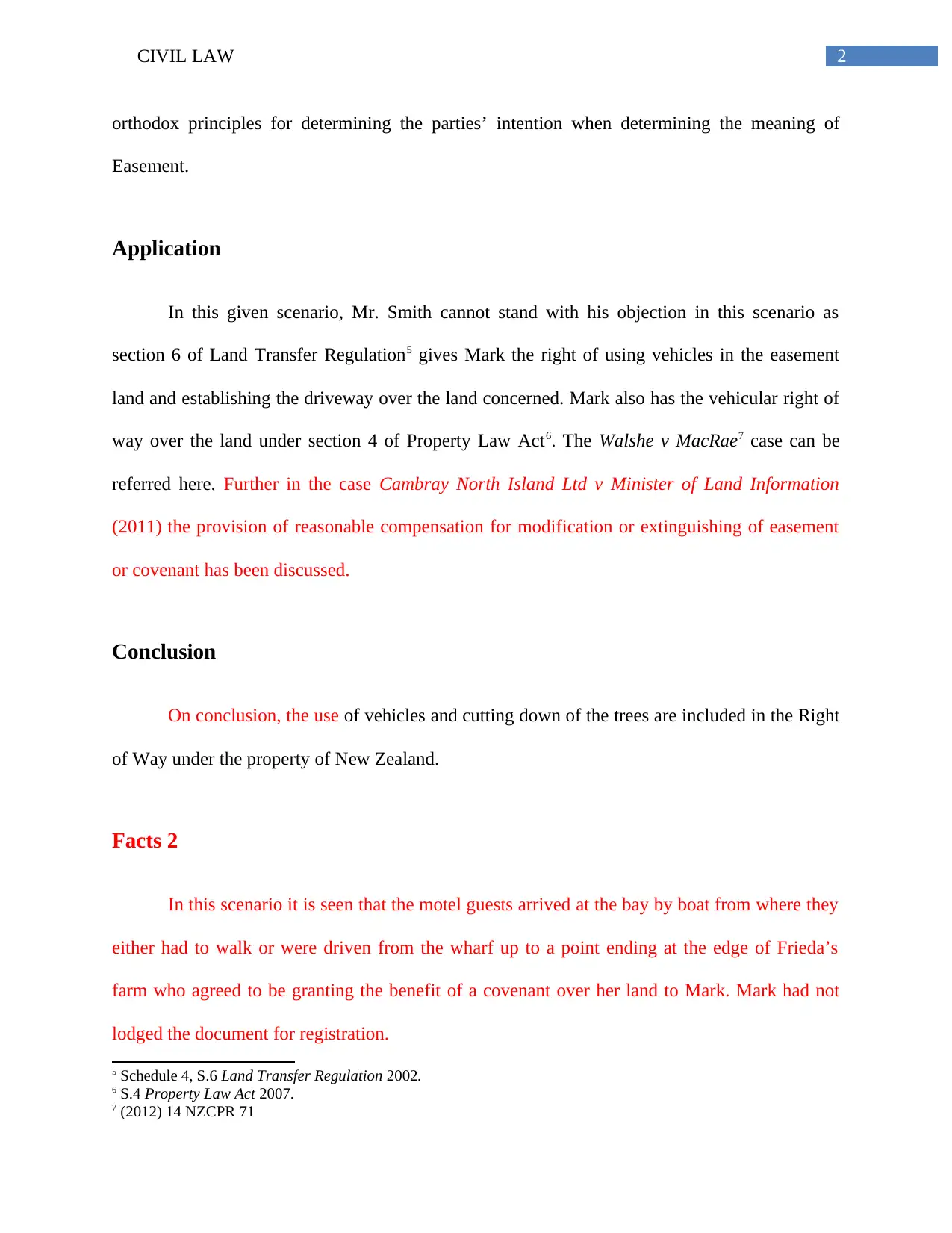
2CIVIL LAW
orthodox principles for determining the parties’ intention when determining the meaning of
Easement.
Application
In this given scenario, Mr. Smith cannot stand with his objection in this scenario as
section 6 of Land Transfer Regulation5 gives Mark the right of using vehicles in the easement
land and establishing the driveway over the land concerned. Mark also has the vehicular right of
way over the land under section 4 of Property Law Act6. The Walshe v MacRae7 case can be
referred here. Further in the case Cambray North Island Ltd v Minister of Land Information
(2011) the provision of reasonable compensation for modification or extinguishing of easement
or covenant has been discussed.
Conclusion
On conclusion, the use of vehicles and cutting down of the trees are included in the Right
of Way under the property of New Zealand.
Facts 2
In this scenario it is seen that the motel guests arrived at the bay by boat from where they
either had to walk or were driven from the wharf up to a point ending at the edge of Frieda’s
farm who agreed to be granting the benefit of a covenant over her land to Mark. Mark had not
lodged the document for registration.
5 Schedule 4, S.6 Land Transfer Regulation 2002.
6 S.4 Property Law Act 2007.
7 (2012) 14 NZCPR 71
orthodox principles for determining the parties’ intention when determining the meaning of
Easement.
Application
In this given scenario, Mr. Smith cannot stand with his objection in this scenario as
section 6 of Land Transfer Regulation5 gives Mark the right of using vehicles in the easement
land and establishing the driveway over the land concerned. Mark also has the vehicular right of
way over the land under section 4 of Property Law Act6. The Walshe v MacRae7 case can be
referred here. Further in the case Cambray North Island Ltd v Minister of Land Information
(2011) the provision of reasonable compensation for modification or extinguishing of easement
or covenant has been discussed.
Conclusion
On conclusion, the use of vehicles and cutting down of the trees are included in the Right
of Way under the property of New Zealand.
Facts 2
In this scenario it is seen that the motel guests arrived at the bay by boat from where they
either had to walk or were driven from the wharf up to a point ending at the edge of Frieda’s
farm who agreed to be granting the benefit of a covenant over her land to Mark. Mark had not
lodged the document for registration.
5 Schedule 4, S.6 Land Transfer Regulation 2002.
6 S.4 Property Law Act 2007.
7 (2012) 14 NZCPR 71
⊘ This is a preview!⊘
Do you want full access?
Subscribe today to unlock all pages.

Trusted by 1+ million students worldwide
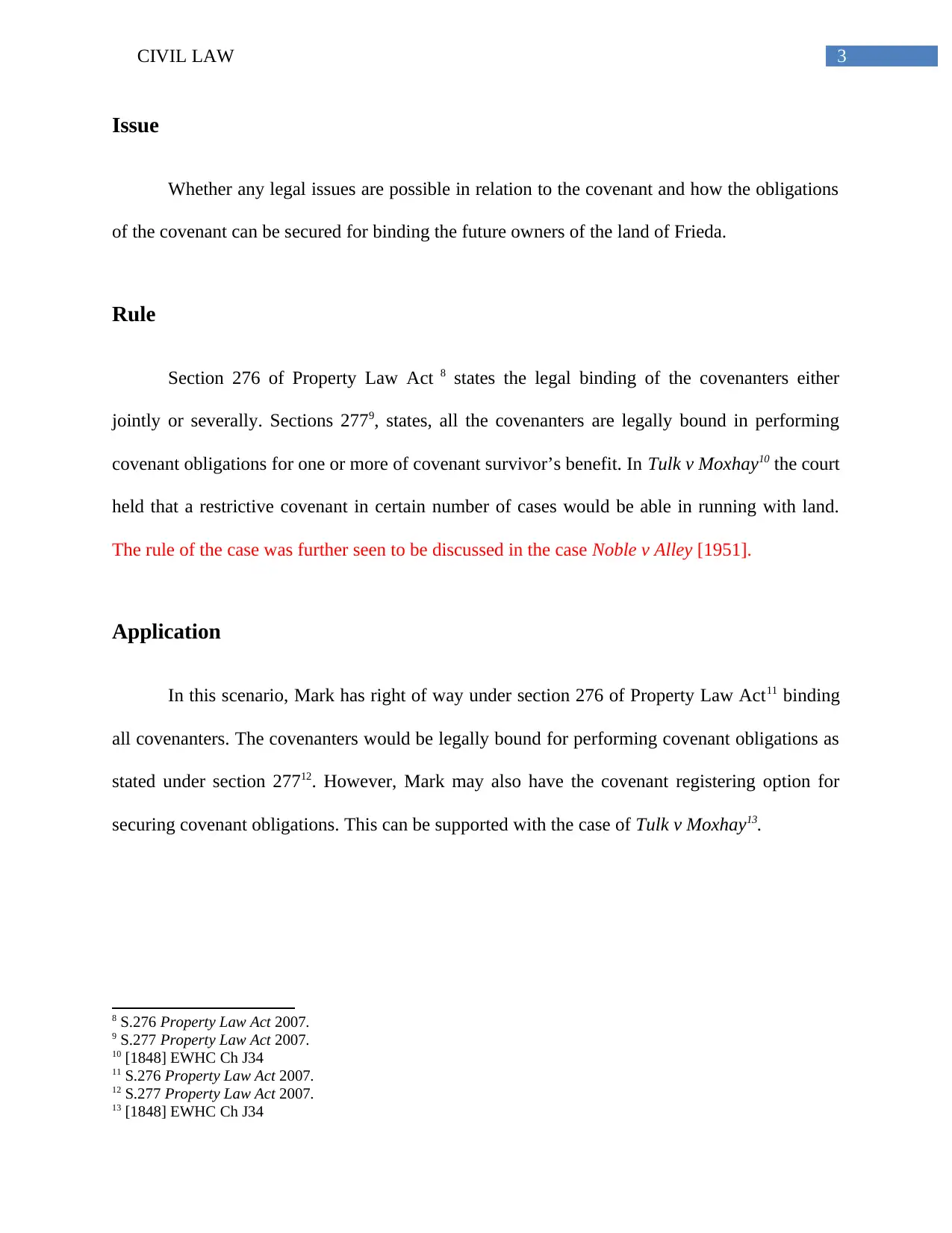
3CIVIL LAW
Issue
Whether any legal issues are possible in relation to the covenant and how the obligations
of the covenant can be secured for binding the future owners of the land of Frieda.
Rule
Section 276 of Property Law Act 8 states the legal binding of the covenanters either
jointly or severally. Sections 2779, states, all the covenanters are legally bound in performing
covenant obligations for one or more of covenant survivor’s benefit. In Tulk v Moxhay10 the court
held that a restrictive covenant in certain number of cases would be able in running with land.
The rule of the case was further seen to be discussed in the case Noble v Alley [1951].
Application
In this scenario, Mark has right of way under section 276 of Property Law Act11 binding
all covenanters. The covenanters would be legally bound for performing covenant obligations as
stated under section 27712. However, Mark may also have the covenant registering option for
securing covenant obligations. This can be supported with the case of Tulk v Moxhay13.
8 S.276 Property Law Act 2007.
9 S.277 Property Law Act 2007.
10 [1848] EWHC Ch J34
11 S.276 Property Law Act 2007.
12 S.277 Property Law Act 2007.
13 [1848] EWHC Ch J34
Issue
Whether any legal issues are possible in relation to the covenant and how the obligations
of the covenant can be secured for binding the future owners of the land of Frieda.
Rule
Section 276 of Property Law Act 8 states the legal binding of the covenanters either
jointly or severally. Sections 2779, states, all the covenanters are legally bound in performing
covenant obligations for one or more of covenant survivor’s benefit. In Tulk v Moxhay10 the court
held that a restrictive covenant in certain number of cases would be able in running with land.
The rule of the case was further seen to be discussed in the case Noble v Alley [1951].
Application
In this scenario, Mark has right of way under section 276 of Property Law Act11 binding
all covenanters. The covenanters would be legally bound for performing covenant obligations as
stated under section 27712. However, Mark may also have the covenant registering option for
securing covenant obligations. This can be supported with the case of Tulk v Moxhay13.
8 S.276 Property Law Act 2007.
9 S.277 Property Law Act 2007.
10 [1848] EWHC Ch J34
11 S.276 Property Law Act 2007.
12 S.277 Property Law Act 2007.
13 [1848] EWHC Ch J34
Paraphrase This Document
Need a fresh take? Get an instant paraphrase of this document with our AI Paraphraser
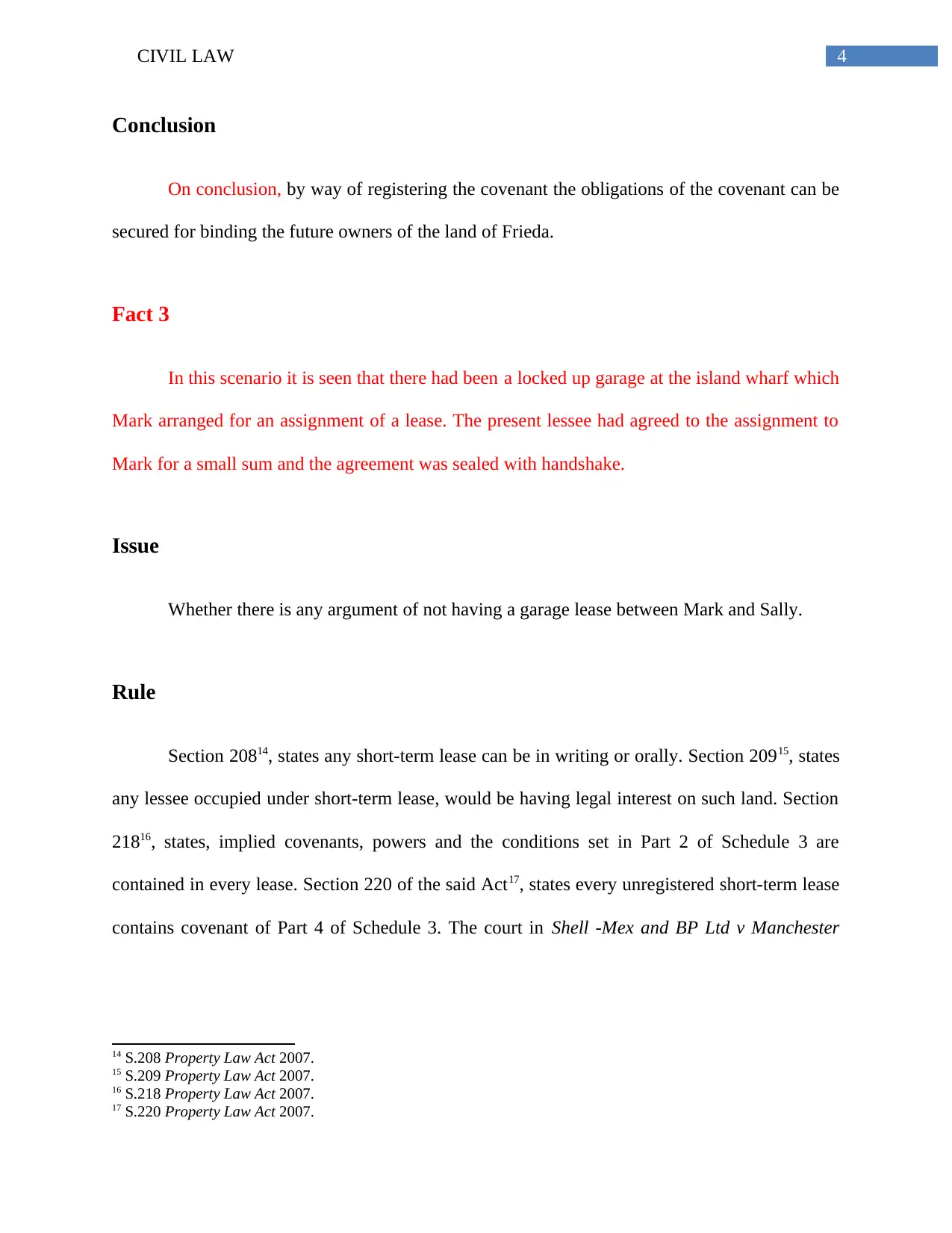
4CIVIL LAW
Conclusion
On conclusion, by way of registering the covenant the obligations of the covenant can be
secured for binding the future owners of the land of Frieda.
Fact 3
In this scenario it is seen that there had been a locked up garage at the island wharf which
Mark arranged for an assignment of a lease. The present lessee had agreed to the assignment to
Mark for a small sum and the agreement was sealed with handshake.
Issue
Whether there is any argument of not having a garage lease between Mark and Sally.
Rule
Section 20814, states any short-term lease can be in writing or orally. Section 20915, states
any lessee occupied under short-term lease, would be having legal interest on such land. Section
21816, states, implied covenants, powers and the conditions set in Part 2 of Schedule 3 are
contained in every lease. Section 220 of the said Act17, states every unregistered short-term lease
contains covenant of Part 4 of Schedule 3. The court in Shell -Mex and BP Ltd v Manchester
14 S.208 Property Law Act 2007.
15 S.209 Property Law Act 2007.
16 S.218 Property Law Act 2007.
17 S.220 Property Law Act 2007.
Conclusion
On conclusion, by way of registering the covenant the obligations of the covenant can be
secured for binding the future owners of the land of Frieda.
Fact 3
In this scenario it is seen that there had been a locked up garage at the island wharf which
Mark arranged for an assignment of a lease. The present lessee had agreed to the assignment to
Mark for a small sum and the agreement was sealed with handshake.
Issue
Whether there is any argument of not having a garage lease between Mark and Sally.
Rule
Section 20814, states any short-term lease can be in writing or orally. Section 20915, states
any lessee occupied under short-term lease, would be having legal interest on such land. Section
21816, states, implied covenants, powers and the conditions set in Part 2 of Schedule 3 are
contained in every lease. Section 220 of the said Act17, states every unregistered short-term lease
contains covenant of Part 4 of Schedule 3. The court in Shell -Mex and BP Ltd v Manchester
14 S.208 Property Law Act 2007.
15 S.209 Property Law Act 2007.
16 S.218 Property Law Act 2007.
17 S.220 Property Law Act 2007.
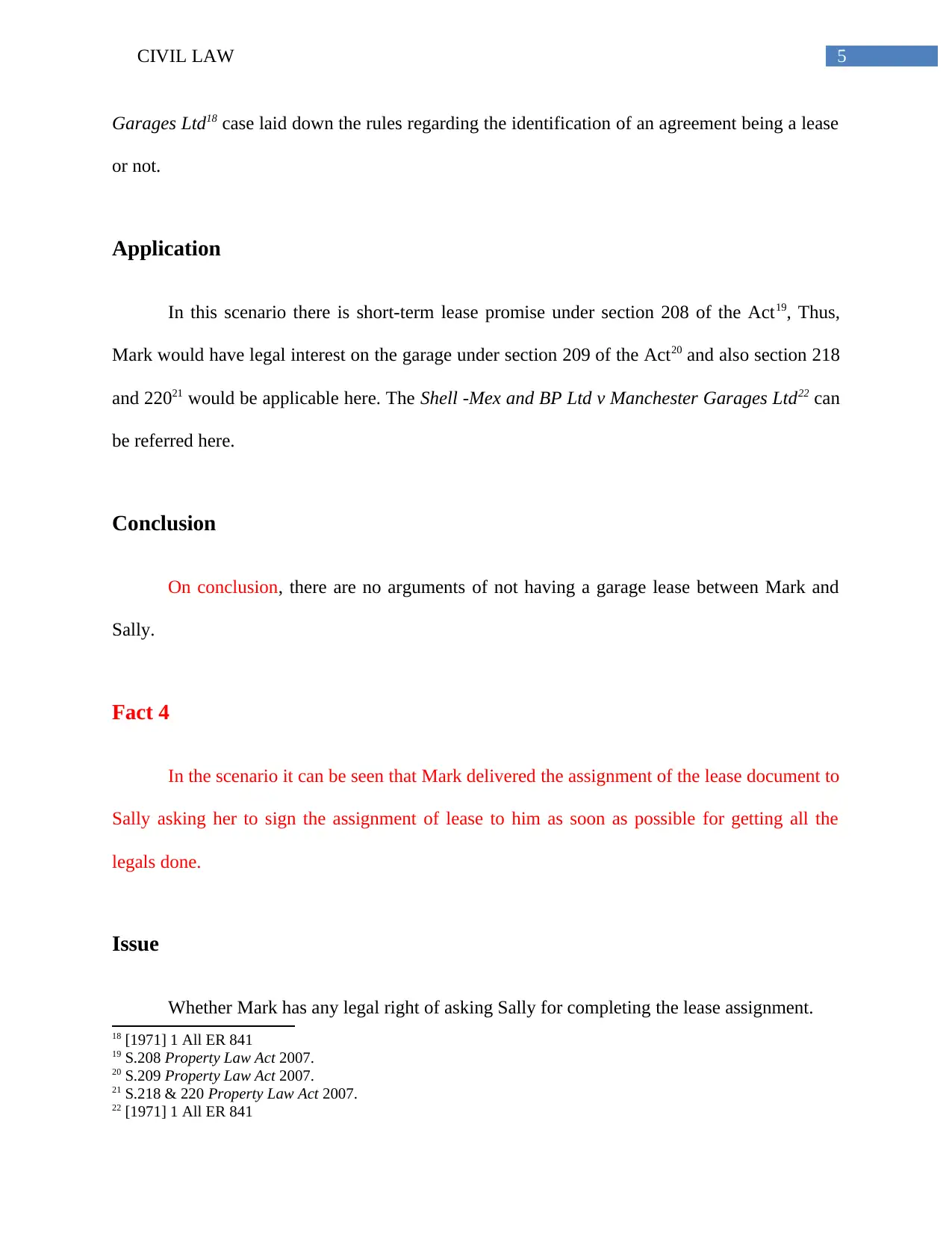
5CIVIL LAW
Garages Ltd18 case laid down the rules regarding the identification of an agreement being a lease
or not.
Application
In this scenario there is short-term lease promise under section 208 of the Act19, Thus,
Mark would have legal interest on the garage under section 209 of the Act20 and also section 218
and 22021 would be applicable here. The Shell -Mex and BP Ltd v Manchester Garages Ltd22 can
be referred here.
Conclusion
On conclusion, there are no arguments of not having a garage lease between Mark and
Sally.
Fact 4
In the scenario it can be seen that Mark delivered the assignment of the lease document to
Sally asking her to sign the assignment of lease to him as soon as possible for getting all the
legals done.
Issue
Whether Mark has any legal right of asking Sally for completing the lease assignment.
18 [1971] 1 All ER 841
19 S.208 Property Law Act 2007.
20 S.209 Property Law Act 2007.
21 S.218 & 220 Property Law Act 2007.
22 [1971] 1 All ER 841
Garages Ltd18 case laid down the rules regarding the identification of an agreement being a lease
or not.
Application
In this scenario there is short-term lease promise under section 208 of the Act19, Thus,
Mark would have legal interest on the garage under section 209 of the Act20 and also section 218
and 22021 would be applicable here. The Shell -Mex and BP Ltd v Manchester Garages Ltd22 can
be referred here.
Conclusion
On conclusion, there are no arguments of not having a garage lease between Mark and
Sally.
Fact 4
In the scenario it can be seen that Mark delivered the assignment of the lease document to
Sally asking her to sign the assignment of lease to him as soon as possible for getting all the
legals done.
Issue
Whether Mark has any legal right of asking Sally for completing the lease assignment.
18 [1971] 1 All ER 841
19 S.208 Property Law Act 2007.
20 S.209 Property Law Act 2007.
21 S.218 & 220 Property Law Act 2007.
22 [1971] 1 All ER 841
⊘ This is a preview!⊘
Do you want full access?
Subscribe today to unlock all pages.

Trusted by 1+ million students worldwide
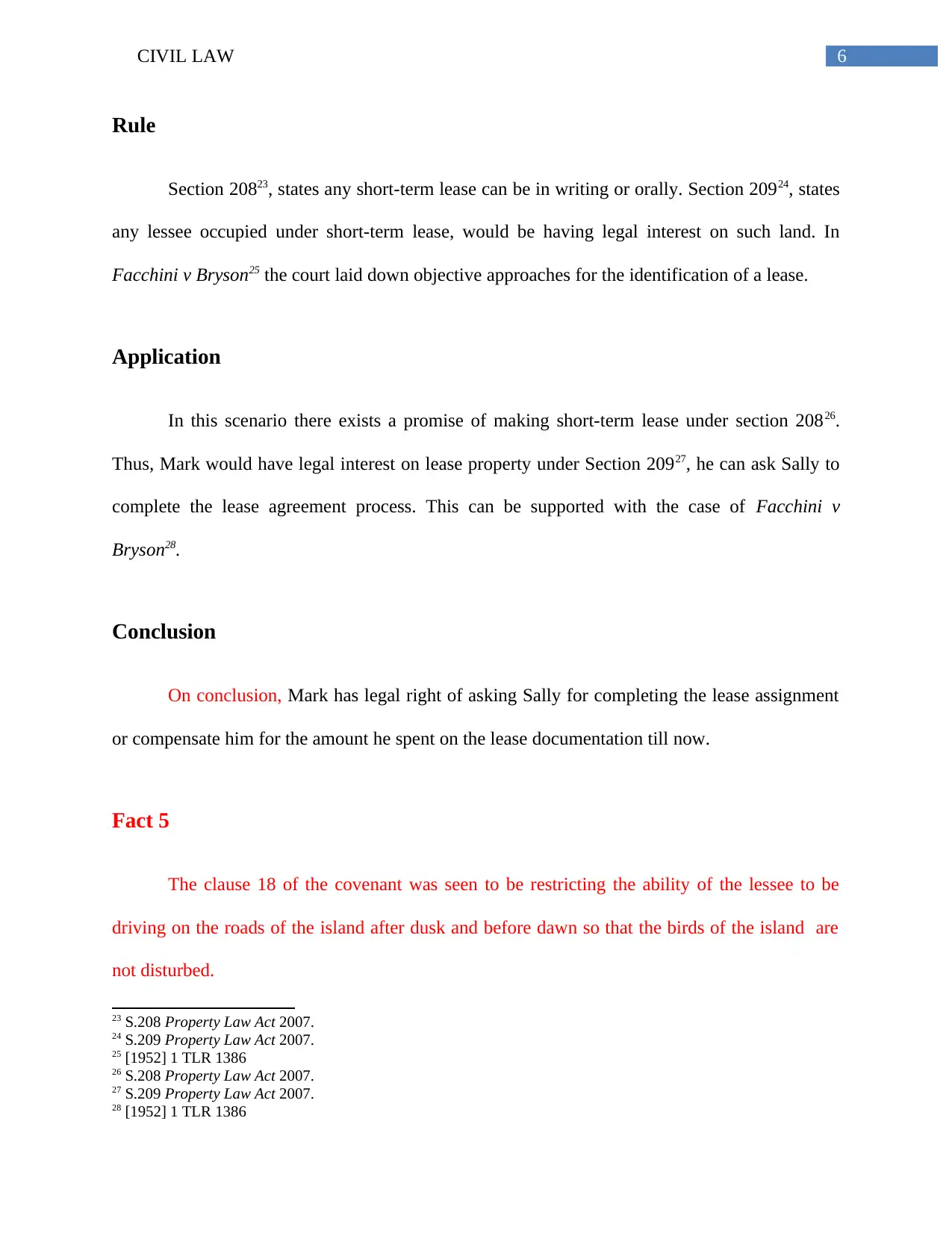
6CIVIL LAW
Rule
Section 20823, states any short-term lease can be in writing or orally. Section 20924, states
any lessee occupied under short-term lease, would be having legal interest on such land. In
Facchini v Bryson25 the court laid down objective approaches for the identification of a lease.
Application
In this scenario there exists a promise of making short-term lease under section 20826.
Thus, Mark would have legal interest on lease property under Section 20927, he can ask Sally to
complete the lease agreement process. This can be supported with the case of Facchini v
Bryson28.
Conclusion
On conclusion, Mark has legal right of asking Sally for completing the lease assignment
or compensate him for the amount he spent on the lease documentation till now.
Fact 5
The clause 18 of the covenant was seen to be restricting the ability of the lessee to be
driving on the roads of the island after dusk and before dawn so that the birds of the island are
not disturbed.
23 S.208 Property Law Act 2007.
24 S.209 Property Law Act 2007.
25 [1952] 1 TLR 1386
26 S.208 Property Law Act 2007.
27 S.209 Property Law Act 2007.
28 [1952] 1 TLR 1386
Rule
Section 20823, states any short-term lease can be in writing or orally. Section 20924, states
any lessee occupied under short-term lease, would be having legal interest on such land. In
Facchini v Bryson25 the court laid down objective approaches for the identification of a lease.
Application
In this scenario there exists a promise of making short-term lease under section 20826.
Thus, Mark would have legal interest on lease property under Section 20927, he can ask Sally to
complete the lease agreement process. This can be supported with the case of Facchini v
Bryson28.
Conclusion
On conclusion, Mark has legal right of asking Sally for completing the lease assignment
or compensate him for the amount he spent on the lease documentation till now.
Fact 5
The clause 18 of the covenant was seen to be restricting the ability of the lessee to be
driving on the roads of the island after dusk and before dawn so that the birds of the island are
not disturbed.
23 S.208 Property Law Act 2007.
24 S.209 Property Law Act 2007.
25 [1952] 1 TLR 1386
26 S.208 Property Law Act 2007.
27 S.209 Property Law Act 2007.
28 [1952] 1 TLR 1386
Paraphrase This Document
Need a fresh take? Get an instant paraphrase of this document with our AI Paraphraser
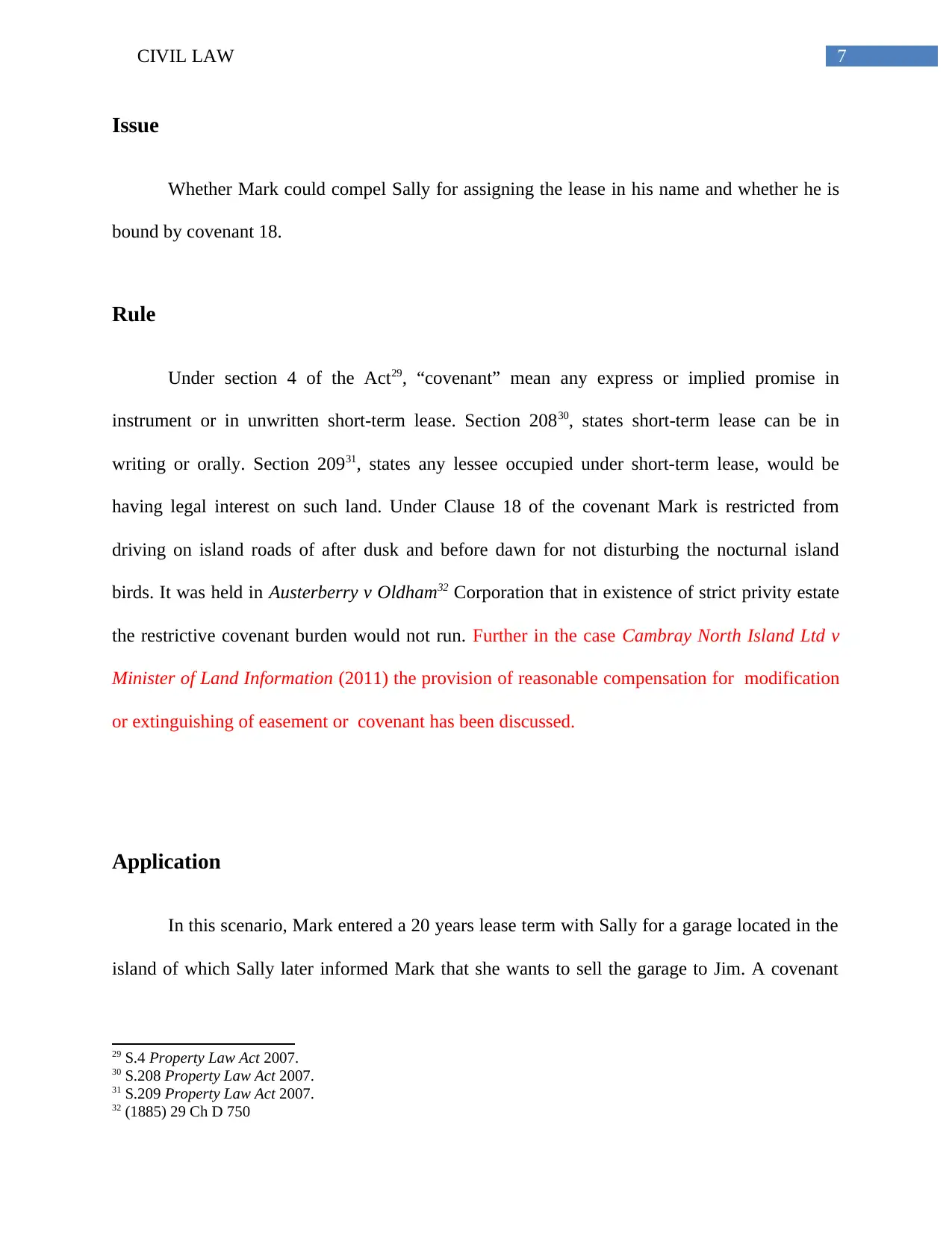
7CIVIL LAW
Issue
Whether Mark could compel Sally for assigning the lease in his name and whether he is
bound by covenant 18.
Rule
Under section 4 of the Act29, “covenant” mean any express or implied promise in
instrument or in unwritten short-term lease. Section 20830, states short-term lease can be in
writing or orally. Section 20931, states any lessee occupied under short-term lease, would be
having legal interest on such land. Under Clause 18 of the covenant Mark is restricted from
driving on island roads of after dusk and before dawn for not disturbing the nocturnal island
birds. It was held in Austerberry v Oldham32 Corporation that in existence of strict privity estate
the restrictive covenant burden would not run. Further in the case Cambray North Island Ltd v
Minister of Land Information (2011) the provision of reasonable compensation for modification
or extinguishing of easement or covenant has been discussed.
Application
In this scenario, Mark entered a 20 years lease term with Sally for a garage located in the
island of which Sally later informed Mark that she wants to sell the garage to Jim. A covenant
29 S.4 Property Law Act 2007.
30 S.208 Property Law Act 2007.
31 S.209 Property Law Act 2007.
32 (1885) 29 Ch D 750
Issue
Whether Mark could compel Sally for assigning the lease in his name and whether he is
bound by covenant 18.
Rule
Under section 4 of the Act29, “covenant” mean any express or implied promise in
instrument or in unwritten short-term lease. Section 20830, states short-term lease can be in
writing or orally. Section 20931, states any lessee occupied under short-term lease, would be
having legal interest on such land. Under Clause 18 of the covenant Mark is restricted from
driving on island roads of after dusk and before dawn for not disturbing the nocturnal island
birds. It was held in Austerberry v Oldham32 Corporation that in existence of strict privity estate
the restrictive covenant burden would not run. Further in the case Cambray North Island Ltd v
Minister of Land Information (2011) the provision of reasonable compensation for modification
or extinguishing of easement or covenant has been discussed.
Application
In this scenario, Mark entered a 20 years lease term with Sally for a garage located in the
island of which Sally later informed Mark that she wants to sell the garage to Jim. A covenant
29 S.4 Property Law Act 2007.
30 S.208 Property Law Act 2007.
31 S.209 Property Law Act 2007.
32 (1885) 29 Ch D 750
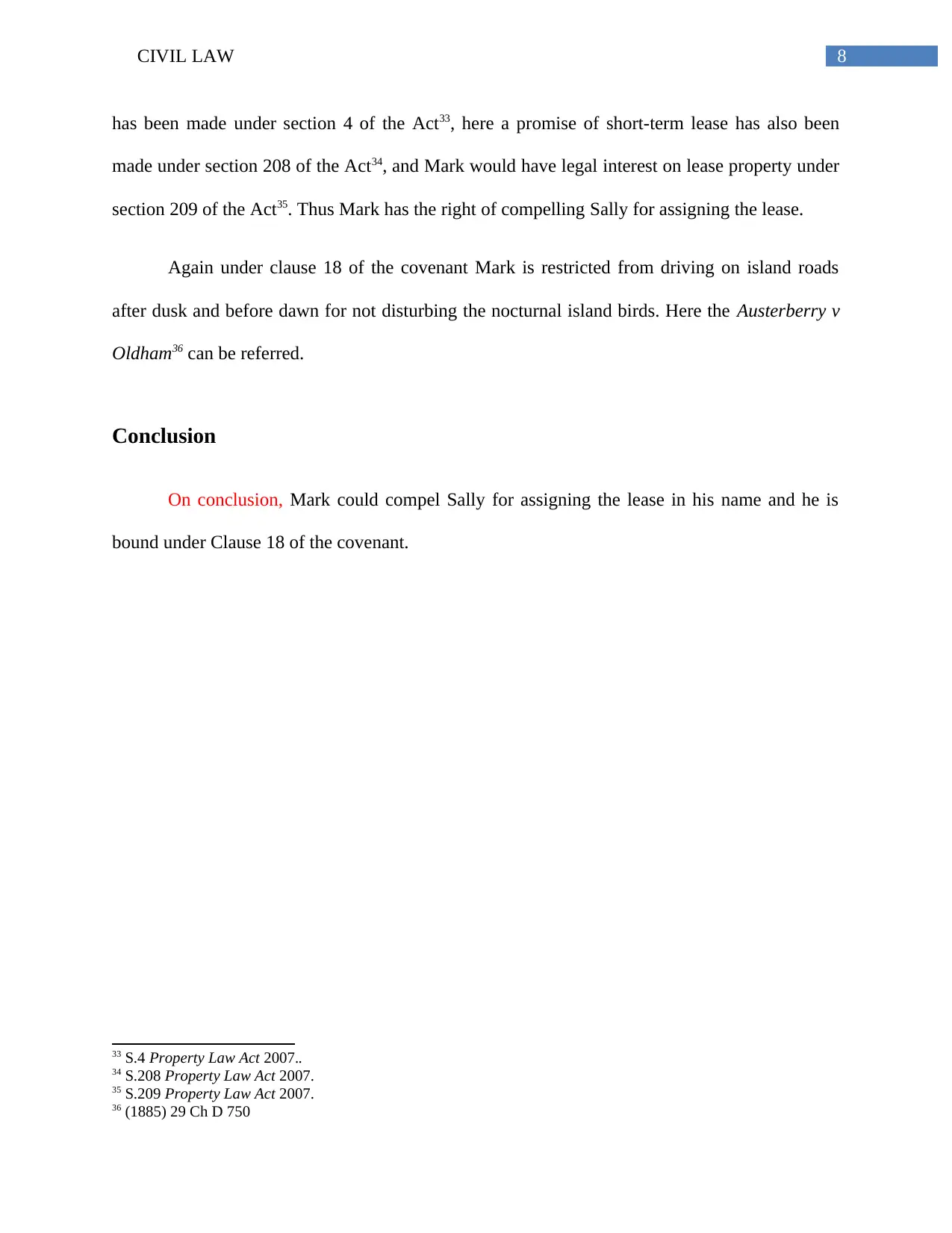
8CIVIL LAW
has been made under section 4 of the Act33, here a promise of short-term lease has also been
made under section 208 of the Act34, and Mark would have legal interest on lease property under
section 209 of the Act35. Thus Mark has the right of compelling Sally for assigning the lease.
Again under clause 18 of the covenant Mark is restricted from driving on island roads
after dusk and before dawn for not disturbing the nocturnal island birds. Here the Austerberry v
Oldham36 can be referred.
Conclusion
On conclusion, Mark could compel Sally for assigning the lease in his name and he is
bound under Clause 18 of the covenant.
33 S.4 Property Law Act 2007..
34 S.208 Property Law Act 2007.
35 S.209 Property Law Act 2007.
36 (1885) 29 Ch D 750
has been made under section 4 of the Act33, here a promise of short-term lease has also been
made under section 208 of the Act34, and Mark would have legal interest on lease property under
section 209 of the Act35. Thus Mark has the right of compelling Sally for assigning the lease.
Again under clause 18 of the covenant Mark is restricted from driving on island roads
after dusk and before dawn for not disturbing the nocturnal island birds. Here the Austerberry v
Oldham36 can be referred.
Conclusion
On conclusion, Mark could compel Sally for assigning the lease in his name and he is
bound under Clause 18 of the covenant.
33 S.4 Property Law Act 2007..
34 S.208 Property Law Act 2007.
35 S.209 Property Law Act 2007.
36 (1885) 29 Ch D 750
⊘ This is a preview!⊘
Do you want full access?
Subscribe today to unlock all pages.

Trusted by 1+ million students worldwide
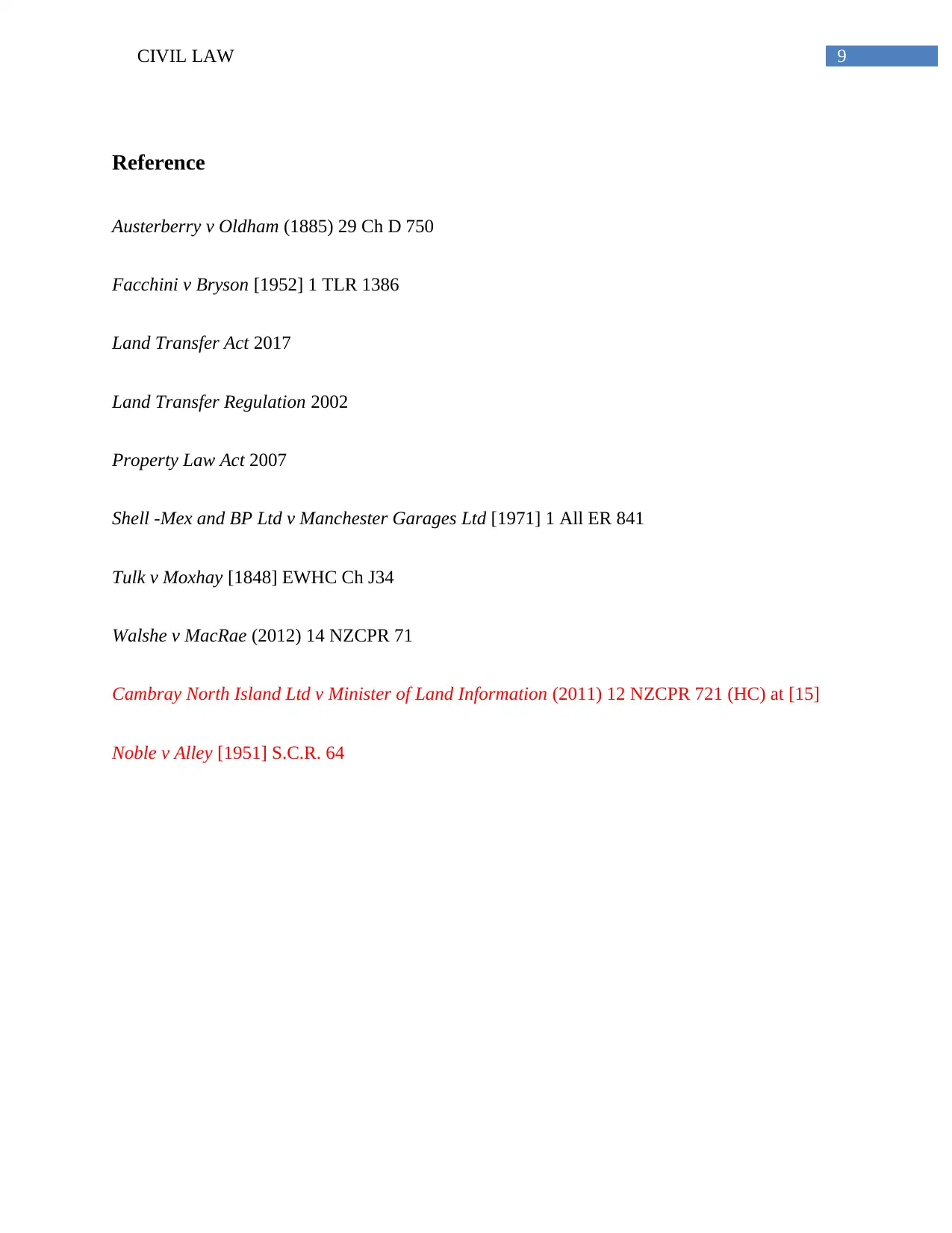
9CIVIL LAW
Reference
Austerberry v Oldham (1885) 29 Ch D 750
Facchini v Bryson [1952] 1 TLR 1386
Land Transfer Act 2017
Land Transfer Regulation 2002
Property Law Act 2007
Shell -Mex and BP Ltd v Manchester Garages Ltd [1971] 1 All ER 841
Tulk v Moxhay [1848] EWHC Ch J34
Walshe v MacRae (2012) 14 NZCPR 71
Cambray North Island Ltd v Minister of Land Information (2011) 12 NZCPR 721 (HC) at [15]
Noble v Alley [1951] S.C.R. 64
Reference
Austerberry v Oldham (1885) 29 Ch D 750
Facchini v Bryson [1952] 1 TLR 1386
Land Transfer Act 2017
Land Transfer Regulation 2002
Property Law Act 2007
Shell -Mex and BP Ltd v Manchester Garages Ltd [1971] 1 All ER 841
Tulk v Moxhay [1848] EWHC Ch J34
Walshe v MacRae (2012) 14 NZCPR 71
Cambray North Island Ltd v Minister of Land Information (2011) 12 NZCPR 721 (HC) at [15]
Noble v Alley [1951] S.C.R. 64
1 out of 10
Your All-in-One AI-Powered Toolkit for Academic Success.
+13062052269
info@desklib.com
Available 24*7 on WhatsApp / Email
![[object Object]](/_next/static/media/star-bottom.7253800d.svg)
Unlock your academic potential
Copyright © 2020–2025 A2Z Services. All Rights Reserved. Developed and managed by ZUCOL.
